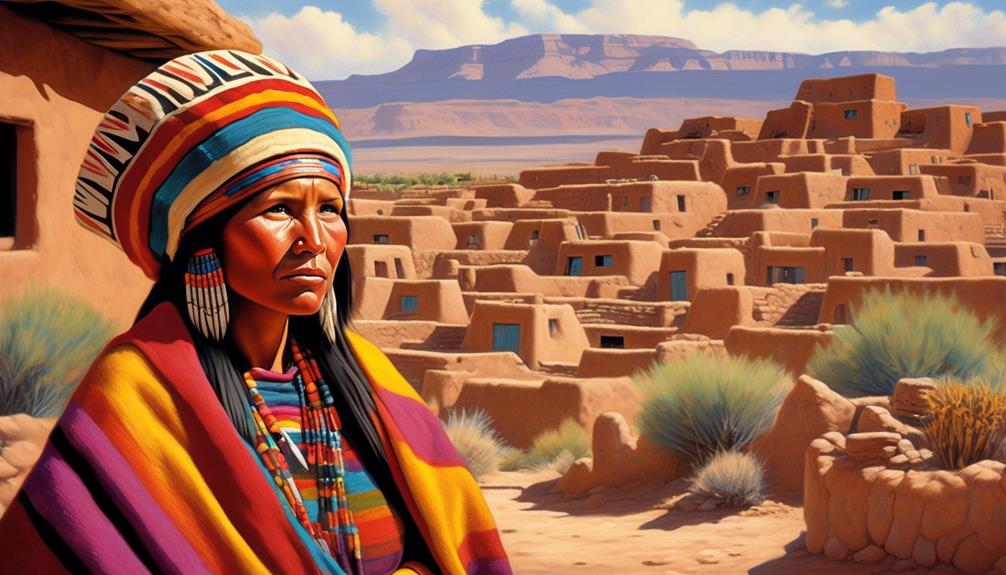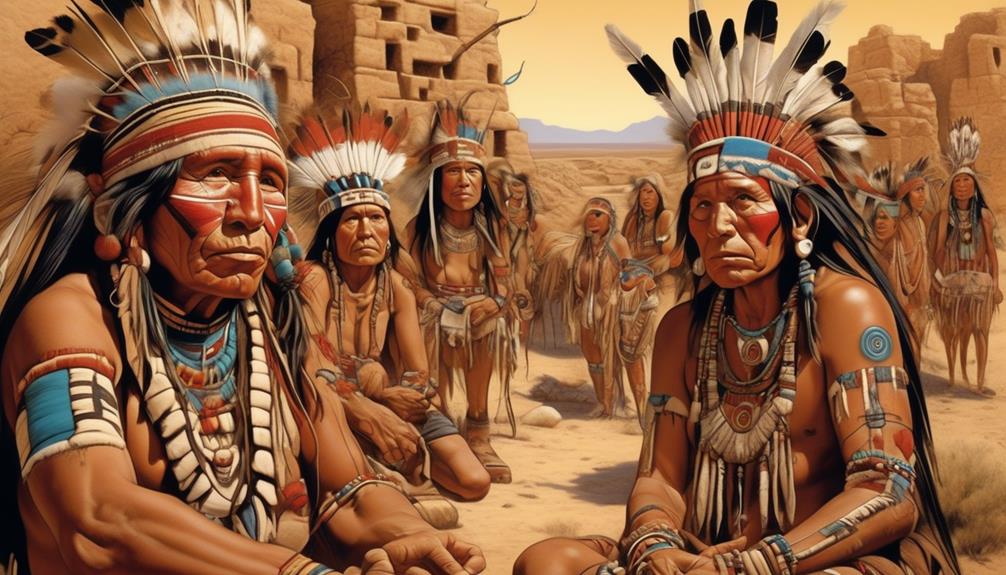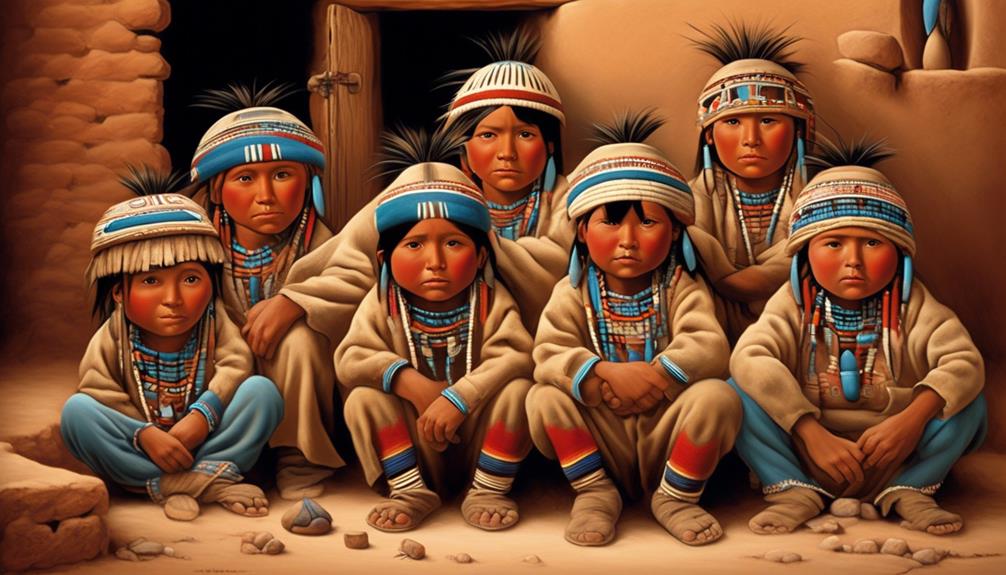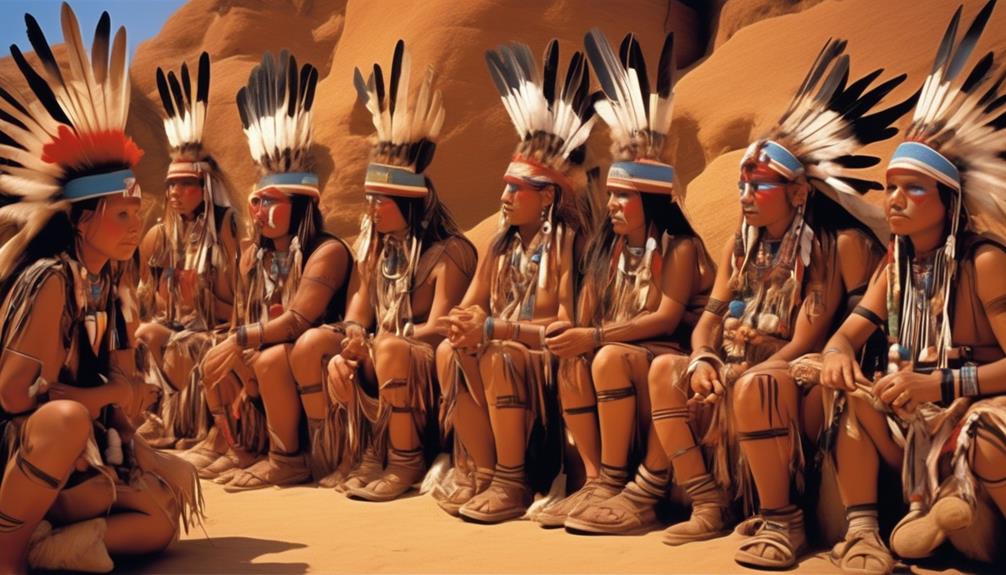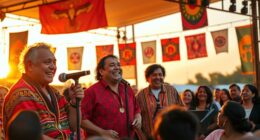Located in the rugged, red landscapes of the American Southwest, the ancestral territories of the Hopi Tribe have a timeless charm and cultural importance.
As we explore the geographical location of the Hopi Tribe, we will uncover the unique connection they have to the Colorado Plateau and the challenges they face in preserving their rich heritage.
But where exactly is this intriguing tribe located, and what does their environment reveal about their traditions and way of life?
Key Takeaways
- The Hopi Tribe is located in northeastern Arizona.
- The tribe's location is characterized by stunning and unique landscapes, such as rugged terrain, dramatic mesas, crimson cliffs, and expansive skies.
- The geographical significance of the area to the Hopi people preserves their cultural heritage and sovereignty, shapes their traditions and ceremonies, and provides physical sustenance for sacred rituals.
- The tribe faces challenges in preserving their culture due to the rapid pace of modernization, encroachment of outside influences, and the need to balance traditional knowledge with contemporary education systems and economic development.
The Hopi Tribe's Geographical Location
Located in northeastern Arizona, the Hopi Tribe's geographical location is characterized by a stunning and unique landscape, which has played a significant role in shaping their culture and traditions. The Hopi tribe resides in the heart of the American Southwest, where the rugged terrain and dramatic mesas haven't only provided a natural fortress for their villages but also influenced their deep spiritual connection to the land. The breathtaking vistas, with their crimson cliffs and expansive skies, aren't just a backdrop for the Hopi people but an integral part of their identity and traditional practices.
The geographical significance of the Hopi Tribe's location goes beyond just physical surroundings. It encompasses a rich tapestry of beliefs, ceremonies, and agricultural practices deeply rooted in the land. The mesas and buttes aren't only landmarks but also hold sacred meanings, woven into the fabric of everyday life for the Hopi people. This unique setting has nurtured a profound respect for the earth and its resources, shaping the tribe's sustainable and spiritual approach to existence.
The Hopi Tribe's geographical location isn't just a point on a map; it's a living, breathing testament to the enduring connection between a people and their homeland.
The Hopi Reservation: Scope and Boundaries
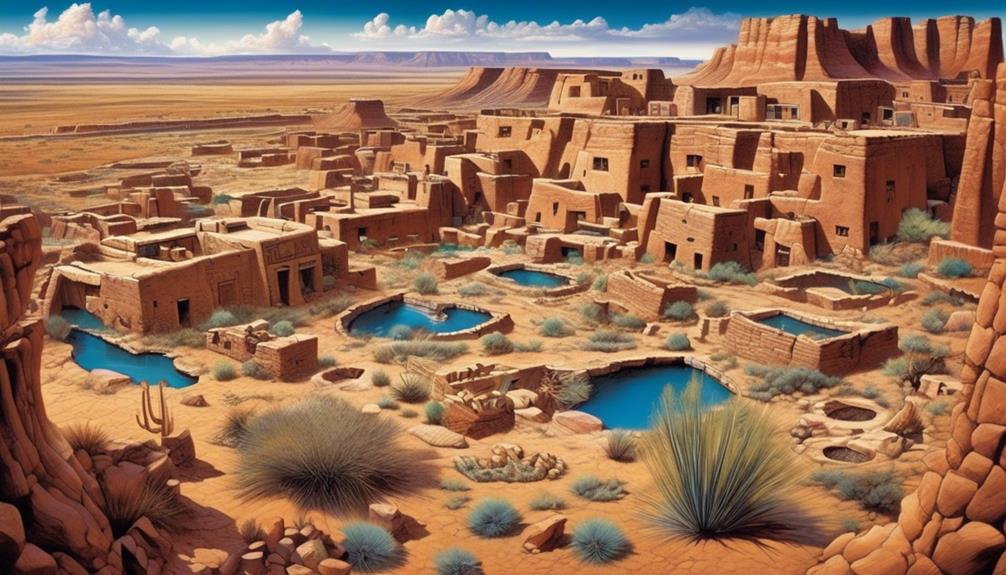
The Hopi Tribe's deep spiritual connection to their land, characterized by its rugged terrain and stunning mesas, extends to the boundaries and scope of the Hopi Reservation, which encapsulates not just physical territory but also cultural heritage and sovereignty.
The Hopi reservation, located in northeastern Arizona, covers approximately 2,531 square miles on the Colorado Plateau. This land holds immense geographical significance to the Hopi people, as it's where their ancestors lived, and where the tribe's traditional practices and ceremonies continue to thrive.
The reservation's boundaries aren't just lines on a map; they represent the preservation of the Hopi way of life, ensuring that their cultural identity and traditions are safeguarded for future generations. This land isn't just a place; it's the heart of the Hopi people, a testament to their tribal sovereignty and resilience in the face of modern influences.
The Hopi reservation serves as a physical and spiritual anchor for their community, anchoring their past, present, and future in the embrace of their ancestral land.
Hopi Tribe's Connection to the Colorado Plateau
Deeply rooted in our history and spirituality, the Colorado Plateau holds a profound significance for the Hopi Tribe. Our connection to the environment is deeply intertwined with the plateau, as it shapes our traditions and ceremonies. The Plateau's diverse landscapes, from mesas to canyons, not only provide physical sustenance but also serve as the backdrop for our sacred rituals and stories that have been passed down through generations.
The Colorado Plateau's unique geology and biodiversity influence our cultural practices and beliefs. The plateau's red rock formations, such as those found at the Grand Canyon and Monument Valley, are integral to our creation stories and traditional ceremonies. We believe that these natural formations are living entities, and our traditions emphasize the importance of maintaining harmony with the environment.
Our connection to the Colorado Plateau extends beyond physical landscapes; it encompasses a spiritual and emotional bond that's embedded in our identity as the Hopi Tribe. The plateau isn't just a location for us; it's a living embodiment of our heritage and traditions.
Challenges of Preserving Hopi Culture
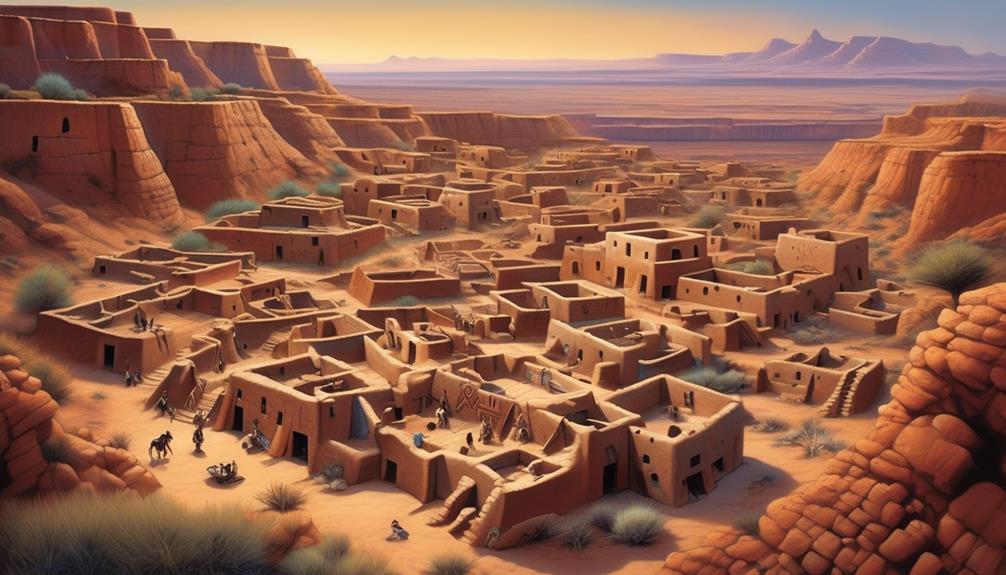
Preserving Hopi culture presents a formidable challenge, given the profound influence of the Colorado Plateau on our traditions and the increasing pressures of modernization and outside influences. The challenges we face in preserving our traditions and cultural identity are deeply rooted in the complexities of the modern world.
Here are the key challenges we encounter:
- Preserving Traditions: The rapid pace of modernization and the encroachment of outside influences pose a significant threat to the continuity of our traditional practices and customs. Striking a balance between adapting to the changing world and safeguarding our ancestral traditions is an ongoing struggle.
- Education Challenges: Ensuring that the younger generation receives a comprehensive education that incorporates our cultural heritage is crucial. However, navigating the integration of traditional knowledge with contemporary education systems remains a persistent challenge.
- Economic Development: Balancing economic development with the preservation of our cultural identity presents a delicate dilemma. We strive to find ways to generate economic opportunities while maintaining the integrity of our cultural values and practices.
Addressing these challenges requires a multifaceted approach that honors our heritage while embracing the opportunities and advancements of the modern era.
Impact of Modernization on the Hopi Tribe

Facing the challenges of modernization, we are witnessing a transformation within the Hopi Tribe that impacts our traditions and cultural identity. The effects of modernization have presented significant challenges to the preservation of our cultural heritage. As we navigate this complex landscape, it is crucial to understand the multifaceted impacts of modernization on the Hopi Tribe.
| Modernization Effects | Cultural Preservation Challenges |
|---|---|
| Introduction of new technologies and lifestyles | Balancing traditional practices with modern ways of living |
| Economic shifts and employment opportunities | Maintaining traditional craftsmanship and artistry |
| Influence of mainstream media and pop culture | Preserving and passing down oral history and traditional knowledge |
These modernization effects have led to a delicate balance between embracing progress and safeguarding our unique cultural identity. The Hopi Tribe faces the ongoing challenge of integrating modern advancements while safeguarding our ancestral customs and beliefs. By addressing these challenges thoughtfully and collaboratively, we strive to ensure the continuity of our cultural heritage for generations to come.
Frequently Asked Questions
What Are the Traditional Ceremonies and Rituals of the Hopi Tribe?
Traditional ceremonies and spiritual rituals are integral to Hopi culture. Our tribe places great importance on cultural preservation and continues to honor ancestral practices.
Ceremonies such as the Kachina dances and the Snake Dance hold deep significance, connecting us to our heritage and spiritual beliefs. These rituals are a profound expression of our connection to the land, our ancestors, and the natural world, fostering a sense of harmony and balance within our community.
How Does the Hopi Tribe Govern Itself and Make Decisions?
In Hopi governance, decision-making processes are rooted in traditional values and consensus-building. The tribe's leaders, known as kikmongwi, hold significant influence, but decisions are often made collectively through open dialogue and deliberation.
Community participation and respect for ancestral customs are central to the decision-making framework. This approach fosters unity and ensures that the tribe's governance aligns with its cultural heritage.
Hopi governance embodies a deep connection to the land and the wisdom of their ancestors.
What Is the Economic Situation of the Hopi Tribe and How Do They Sustain Themselves?
Economic stability is integral to our tribe's sustainability. Our agricultural practices, deeply rooted in tradition, are central to our economic situation. We utilize dry farming techniques, growing corn, beans, and squash.
Additionally, artisans craft exquisite pottery and jewelry, contributing to our economic well-being. Despite challenges, we strive to maintain our economic independence and preserve our cultural heritage through sustainable practices and economic initiatives.
What Are the Current Social and Health Issues Facing the Hopi Tribe?
Facing the Hopi tribe are pressing social and health issues, such as mental health challenges and limited access to education. These issues demand urgent attention and thoughtful solutions.
Mental health disparities and educational barriers undermine the well-being and potential of our community. It's crucial to address these issues with comprehensive, culturally sensitive approaches.
Our tribe's resilience and strength are undeniable, but support and resources are necessary for overcoming these obstacles.
What Are the Relationships and Interactions Between the Hopi Tribe and Other Native American Tribes in the Region?
Intertribal relationships between the Hopi tribe and other Native American tribes in the region are rich with cultural exchange and collaboration. This interaction has been pivotal in fostering economic development and improving healthcare access.
Through mutual respect and shared traditions, we have built strong connections that honor our heritage while embracing progress. Our partnerships with neighboring tribes have strengthened our communities and allowed us to thrive in a modern world while preserving our ancestral customs.
Conclusion
In conclusion, the Hopi Tribe's rich culture and traditions are deeply rooted in the stunning landscapes of the Colorado Plateau. Preserving their way of life in the face of modern challenges is no small feat, but the Hopi people continue to stand strong.
Their connection to the land is as deep as the Grand Canyon and as enduring as the desert sands. It's truly awe-inspiring to witness the resilience and tenacity of the Hopi Tribe.
Mary is a passionate writer who brings creativity and a fresh perspective to our team. Her words have the power to captivate and inspire, making her an essential contributor to our content. Mary’s commitment to storytelling and dedication to promoting Indigenous culture ensures that her work touches the hearts of our readers. We’re fortunate to have her as part of our team.



